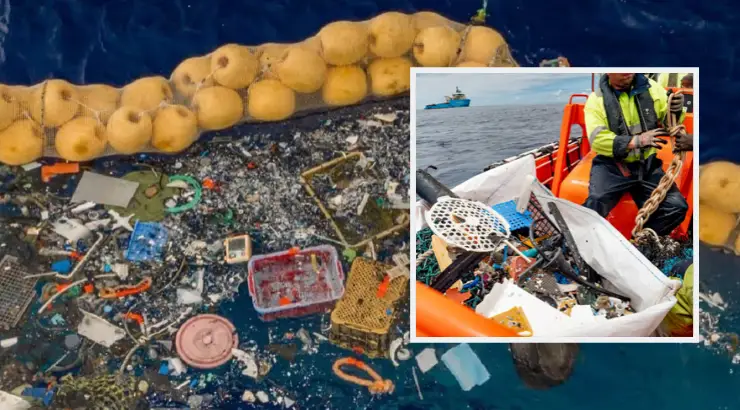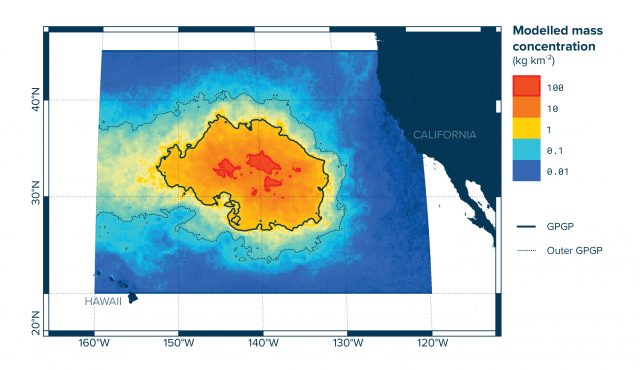Good News
The Ocean Cleanup Device is Finally Hauling in Huge Bags of Plastic Garbage
The team intends to recycle the plastic waste and turn it into some kind of product.

(TMU) — In 2013, 18-year-old Dutch inventor Boyan Slat founded The Ocean Cleanup in his hometown in the Netherlands to develop a system to clean up the Great Pacific Garbage Patch, also described as the Pacific trash vortex. The patch is an immense concentration of garbage in the north-central Pacific Ocean that is more than twice the size of Texas.
Now, six years later, the fruits of this multidisciplinary work are starting to pay off.
The Great Pacific Garbage Patch is sometimes referred to as an island made of garbage floating in the middle of the Pacific, but is that really true? While technically not actually a solid island, it looks just like one at first glance.
It turns out, the plastic is dispersed, forming massive debris fields. The average concentration of the Great Pacific Garbage Patch is around 60 kg per square kilometer as said by Nature, and peaks at several hundred kgs per square kilometer.
In 2013, The Ocean Cleanup debuted a U-shaped device that passively collects plastic in its fold like a giant arm. At first, the system hit several snags, including a flaw that caused the plastic to spill back into the ocean. Several improvements were needed.
But in October of this year, the group announced that the device was finally capturing and retaining plastic. And for the first time, some of the trash was brought back to shore. The group hauled 60 bags of plastic debris into the Vancouver Harbour.
“We actually have the first plastic back on land,” Slat said at a press conference.
“It’s absolute garbage,” Slat said.“This stuff has been in the ocean likely for decades.”
It is sorted, put out to dry, weighed, and tagged. On board, the ocean plastic is processed and classified before it is ready to go on shore. Make sure to tune in on December 12th to see what we will do with it next. pic.twitter.com/D2gsHYdo4p
— The Ocean Cleanup (@TheOceanCleanup) December 5, 2019
The first plastic has arrived on shore. Next stop: September 2020, when we aim to launch the first product made out of plastic from the Great Pacific Garbage Patch. Learn more: https://t.co/hCVDrzhTQJ pic.twitter.com/DCBiqceucy
— The Ocean Cleanup (@TheOceanCleanup) December 12, 2019
The Ocean Cleanup intends to recycle the plastic and turn it into some kind of product. What that item will have yet to be announced, but Slat said the team hoped to start selling it by September 2020.
When The Ocean Cleanup hauled the plastic to shore, it marked the end of mission one. With this, it was proven that its plastic-catching system actually worked. The organization wants to clean up half of the garbage patch in the next five years.
The team explains that we will never be able to remove every single piece of plastic from the oceans. However, by intercepting plastic in rivers, a significant decrease of floating debris in the ocean’s accumulation zones can be achieved. “Calculations show we can clean up 50% of the Great Pacific Garbage Patch every five years,” as said by Slat.
One of the features that we can highlight is that it works by passively collecting. What does this mean?
Actively going after plastic with vessels and nets would be costly of both time and funds, labor-intensive, and harmful to sea life.

Modeled mass concentration of plastic in the Great Pacific Garbage Patch.
“Our technology uses the ocean’s currents to navigate throughout the Great Pacific Garbage Patch, moving in the same manner and patterns that the plastic follows in the accumulation zone, although slightly slower. The difference in speed is what makes concentrating the plastic possible”
The systems will move slower than the plastic because of the parachute anchor. The systems’ slower pace creates a consistent relative speed difference between the system and the plastic, allowing the plastic to be concentrated. This is what passive means for this project.
Let’s wait to see the products that will be created in the next stage of this project. “These are going to be products that you actually want,” Slat said.
By Manuel García Aguilar | Creative Commons | TheMindUnleashed.com
Typos, corrections and/or news tips? Email us at Contact@TheMindUnleashed.com
